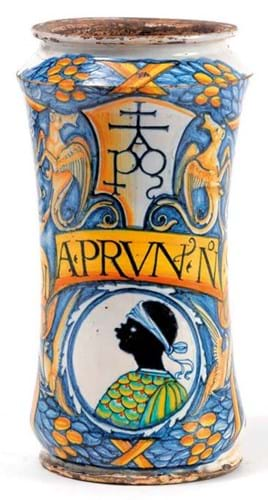
The 16th century Deruta drug jar from the Chompret collection that led the ceramics sale at Peschetau Badin when it sold for €46,000 (£38,655).
The Paris auction firm Peschetau Badin (27% buyer’s premium) held a 148-lot sale of ceramics largely given over to European tin-glazed earthernwares (Italian maiolica and French faience) that had come primarily from two notable collections.
Around half of the 64 lots in the first part of the May 13 auction were from Dr Joseph Chompret (1869-1956), a stomatologist by profession but a ceramics enthusiast and scholar who is best remembered for his faience and maiolica.
The remainder of the auction comprised Provençal French faience from Marseille from Pierre Jourdan-Barry (1926-2016) and was offered for sale by his daughters.
Trailblazing studies
Chompret, a president of la Société des Amis du Musée National de Céramique, not only collected but was also a pioneer in the study of tin-glazed earthernwares, who wrote and published on his special ceramic interests.
He made a study of pharmaceutical drug jars, writing Les Faïences Primitives d’après les apothicaireries hospitalières. He also took part in the drafting of the Répertoire de la Faïence Française which was published under his direction in 1935 following a 1932 exhibition on French faience at the Musée des Arts Decoratifs. And he later produced the Répertoire de la majolique italien.
Chompret’s interests extended to Iznik pottery (his Ottoman collection was sold by the same auction house in 2002), some of which is now in the Louvre Abu Dhabi.
The Chompret lots offered this month largely comprised Italian maiolica (including some pieces that featured in his Répertoire de la majolique Italienne) and French faience with a few examples of Spanish, German, Dutch and Middle Eastern wares.
The highest prices were paid for early examples of his Italian and French drug jars dating from the first half of the 16th century. Topping the list at a hammer price of €46,000 (£38,655) was a slightly waisted 9in (23cm) high albarello or drug jar from Deruta dated to the early 16th century.
Possibly from the workshop of the Masci family, this was decorated with a Moor’s head in profile below a ribbon with the inscription DI A Prunnus and bore the monogram PAQ with a double cross. An albarello from the same series as this piece was reproduced in Chompret’s Répertoire de la majolique Italienne.

A 16th century drug jar from Montelupo from the Chompret collection – €42,000 (£35,295) at Peschetau Badin.
Another Italian drug jar, this one from Montelupo dated to c.1500-10, provided the day’s third-highest price at €42,000 (£35,295). This 10in (25cm) high cylindrical piece which was decorated with a flower circled by a garland of foliage, carried the inscription Pepe Lungo and had a label from Chompret to the underside.
It is one of a group of 10 albarelli and one spouted drug jar all featuring the same flower (possibly a carnation or pomegranate), which is thought to be the emblem of the pharmacy for which they were created.
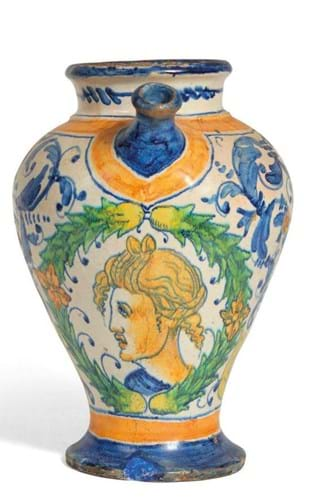
A 16th century French ovoid spouted drug jar from Rouen from the Chompret collection made in the Masseot Albaquesne workshop probably for the Dubosc pharmacy – €44,000 (£36,975) at Peschetau Badin.
The most expensive French faience drug jar at €44,000 (£36,975) came from Rouen and was a spouted ovoid example dating from c.1550, decorated with a female head in profile set in a foliate garland and monogrammed MAB for the Masseot Abaquesne workshop.
It was one of two drug jars in the sale thought to have been part of the large order commissioned from the workshop by the Rouen apothecary Pierre Dubosc in 1545 for over 4000 pharmacy pots that included 3620 albarelli and 432 spouted jars. Both were accompanied by a Chompret labels.
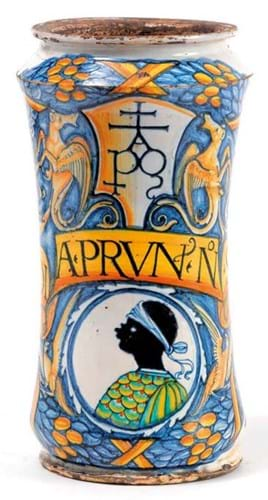
The 16th century Deruta drug jar from the Chompret collection that led the ceramics sale at Peschetau Badin when it sold for €46,000 (£38,655).
The other example was of slightly waisted cylindrical form, measured 11in (28cm) in height and was painted in polychrome with the bust of a man in profile set on a ground of scrolling foliage. This piece had also featured in the 1932 exhibition at the Musée des Art Decoratifs. It realised €24,000 (£20,170).
Family of collectors
Jourdan-Barry, whose faience made up the second half of the auction, came from a family of collectors and grew up in Marseille. His father Raymond was an enthusiast with eclectic tastes who published a book on hallmarks of silver from Aix en Provence and also collected ceramics.
Pierre, a shipbroker by profession, built collections in several different disciplines: French silver; Tibetan bronzes, paintings and works on paper and Iznik pottery; the latter interestingly, like that of Chompret, now in the Abu Dhabi Museum.
But Jourdan-Barry had always retained a strong affection for the faience produced in the region where he spent his childhood. He donated pieces to the Musée de la Faïence de Marseille and the Musée national de céramique at Sèvres.
The pieces on offer at Peschetau-Badin were all produced in the south of France in the factories in the Marseille area and had been inherited by three of his daughters.
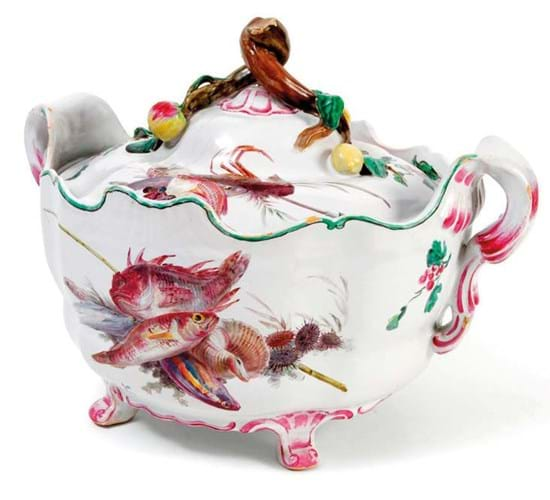
A 17th century tureen made at the Savy workshop in Marseille from the Jourdan-Barry collection – €33,000 (£27,730) at Peschetau Badin.
The most expensive lot from his collection by a considerable margin proved to be a 18th century covered tureen measuring 14in (36cm) in width which was attributed to the Savy factory. It featured a wealth of moulded and painted local marine decoration that included coral, shells, mussels, sea urchins, red mullet, seaweed and fishing rods.
This piece, which had a provenance to the collection of Joseph Balas, had also featured in the 1932 French faience exhibition. Estimated at €10,000-15,000, it doubled the guide to take €33,000 (£27,730).
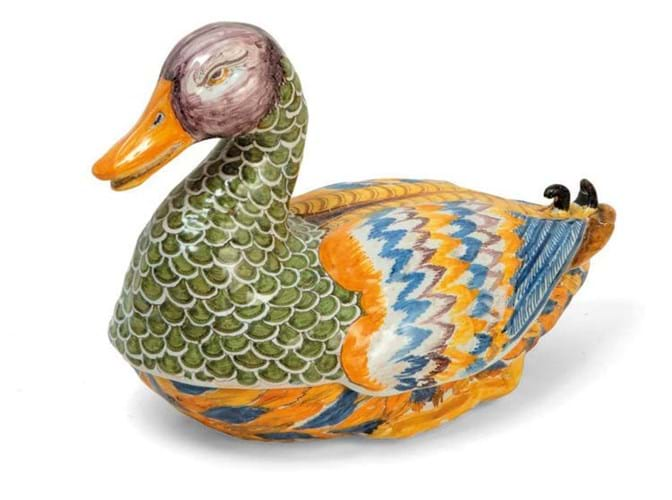
Tureen modelled as a duck from the Fauchier factory from the Jourdan-Barry collection – €11,000 (£9245) at Peschetau Badin.
A 15in (39cm) wide oval platter attributed to the same factory bearing similar decoration also proved sought after, making €8000 (£6720), while a 13in (34cm) wide tureen naturalistically formed and decorated in the shape of a duck from the Fauchier factory in Marseille realised €11,000 (£9245).
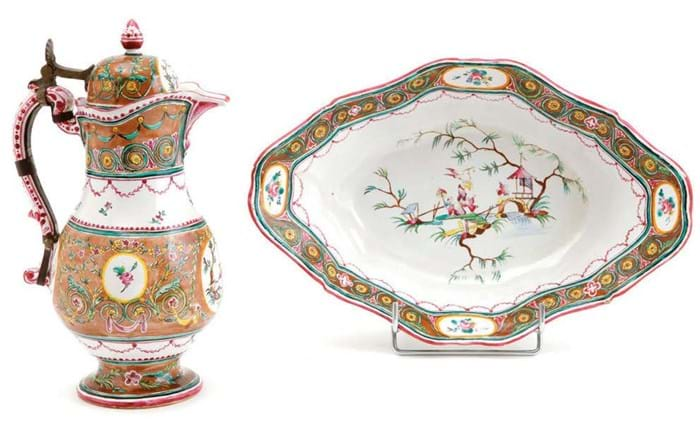
Water jug and stand attributed to the Veuve Perrin factory from the Jourdan-Barry collection which was preempted by the Musée Borely in Marseille at €4500 (£3780) in the auction at Peschetau Badin.
There was also an institutional purchase. The Musée Borély in Marseille acquired a locally made 12in (30cm) high water jug and stand attributed to the Veuve Perrin factory that was decorated with Chinoiseries in the style of Pillement set against a brown ground decorated with knotted ribbons and scrolls and floral garlands.
It was pre-empted by the museum for €4500 (£3780).
£1 = €1.19














